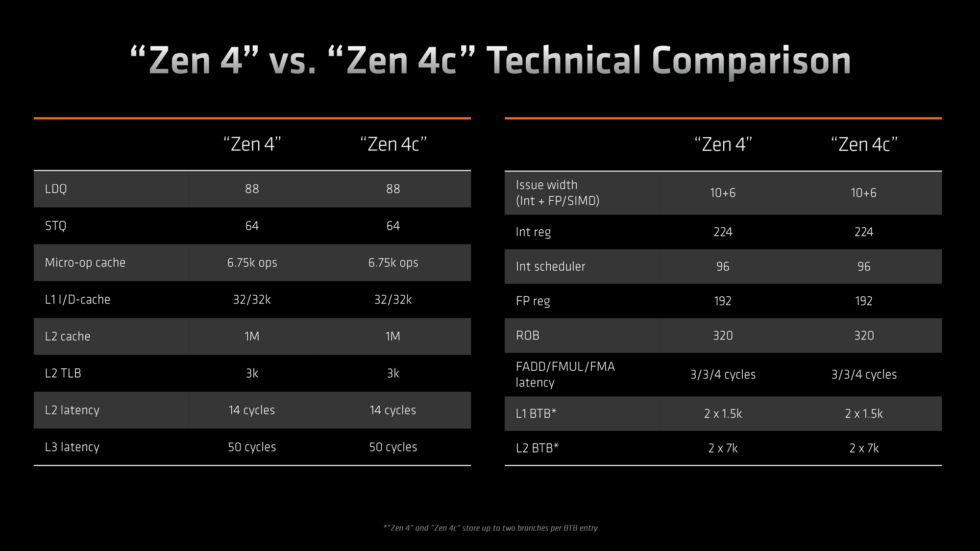
AMD sells a lot of 7000-series Ryzen processors for laptops, but the most advanced ones are in the 7040 family. These are the only chips that combine AMD's latest Zen 4 CPU architecture and its latest RDNA 3 graphics cores, whereas other 7000-series laptop chips mix and match various older CPU and GPU architectures.
Today, the company is announcing two new Ryzen 7040U-series chips for thin and light laptops, but with a twist: They combine regular Zen 4 CPU cores with "Zen 4c" cores that are designed to save space rather than hit high clock speeds (via AnandTech). AMD says that a Zen 4c CPU core has the same capabilities as a Zen 4 core but takes up 35 percent less space in a silicon die.
These new chips are codenamed "Phoenix 2," denoting that they are similar to but distinct from the original Phoenix design used in earlier Ryzen 7040U chips. Phoenix 2 combines two high-performance Zen 4 cores, four high-efficiency Zen 4c cores, and a Radeon 740M integrated GPU with four RDNA3 graphics cores. They also lack the Ryzen AI neural processing unit that accelerates some AI and machine learning tasks in the regular Phoenix chips.
The two new chips being announced today are the Ryzen 5 7545U, which is a fully enabled version of the Phoenix 2 chip. The Ryzen 3 7440U is a cut-down version, with one Zen 4 core and three Zen 4c cores enabled and half the L3 cache.
Technically, this makes these new AMD CPUs a heterogeneous design, like Intel has been shipping for a few years now, or like Apple and other chipmakers have been shipping for even longer. But Intel's big and little cores have used entirely different architectures, which has made supporting them more complicated (only Windows 11 and newer Linux kernels can get the most out of them) and has forced Intel to disable some features that aren't supported by both architectures (AVX-512 support is the most notable casualty).

Zen 4 and Zen 4c, on the other hand, have an identical architecture and feature set. A Zen 4 core takes up more physical space but can scale to higher clock speeds, making it ideally suited to high single-core performance. And Zen 4c has been optimized for die area and efficiency, allowing AMD to fit more cores into the same amount of physical space (or using less physical space for the same number of cores) but preventing its clock speeds from reaching the heights of a regular Zen 4 core.
Zen 4c appeared first in some of AMD's EPYC server processors, where high-density, high-efficiency multithreading is more important than reaching peak clock speeds. And by bringing Zen 4c to notebooks, AMD says that (eventually) it plans to increase total core counts in high-end chips and "deliver more options for consumers" in entry-level chips. This means smaller, cheaper chips that can still do everything other Zen 4 CPUs can do, which will hopefully help break AMD of its habit of recycling years-old chip designs for budget devices.
We've actually already seen one of these Phoenix 2 chips, in the form of the non-Extreme Ryzen Z1 chip that AMD announced for handheld game consoles earlier this year. AMD didn't say as much when the chips were announced, but users found that the Ryzen Z1 used a mix of Zen 4 and Zen 4c cores. AMD has also said that the Ryzen 3 7440U announced in May has secretly been a Phoenix 2 chip this whole time, with a single Zen 4 core and three Zen 4c cores.
Zen 4c is interesting as a technical achievement, and if it enables AMD to introduce cheaper laptop CPUs and high-end models with higher core counts, so much the better. But playing coy with what CPU contains what hardware is just making an already confusing laptop chip generation even more confusing. AMD's numbering system already requires a decoder ring, and there is no specific code for "contains a mix of higher- and lower-performing cores."
Listing image by AMD
reader comments
56 with